Shaving with a straight razor is a daunting task for the uninitiated. Have no mistake about it, you are putting a well honed piece of steel against your skin. But have no fear, it is no more dangerous than any other shaving method if you do it properly. This guide will take you through all the items you need and those you really really want. It will take you through the ins and outs step by step and tell you how to get the best shave you’ve ever had.
Before you get started using a straight razor, please note that shaving with a straight razor has a steep learning curve. In all likelihood you will not get a better shave for a month or longer. However, once you master the straight razor you will experience less irritation, a closer shave, and greater comfort. Plus, it is the greenest way to shave and the most cost effective too.
Introduction
European Straight Razors (AKA cut throat razor, open razor) feature a fixed blade that folds into the handle. Japanese straight razors, known as Kamisori, are a single piece of steel. Once, the only method of shaving, straight razors have become a niche art, practiced only by a few. With the recession, the green movement, and other factors, there has been a growing move back towards straight razors and Double Edge (DE) razors. Concerns such as cost, nostalgia, and “manliness” drive people back towards the straight razor.
Once you master the art of straight razor shaving, you will be able to get a far smoother shave than you can get from any modern method. However, shaving with a straight razor has a long learning curve. While many people believe shaving with a straight razor is dangerous, the reality is that it is no more dangerous than a DE or modern safety razor; you actually have to try to cut yourself or massively mess up to do any real damage.
Even though the straight razor requires a long learning curve, the benefits are worthwhile. Stick with the straight razor even though the DE shaves better and you will be rewarded. If not with a closer and irritation free shave, then by the meditative, relaxing, and manly aspects of straight razor wet shaving. Stick with it and once you have mastered the straight razor (which typically takes around 100 shaves), you will be able to consistently give yourself a shave that’s far better than any shave you’ve ever had before.
Things You’ll Need
- A straight razor.
- Shaving cream, gel, or soap. Check out our reviews on shaving soaps!
- A mirror.
- A strop or leather belt.
- Read our article on inexpensive strops if you don’t want to buy one just yet.
Recommended Items
- A bowl, mug, or scuttle.
- A shaving brush, preferably badger.
- Styptic pencil for cuts.
- Alum stick/block.
- Check out our article on what should be in your straight razor shaving kit!
Warnings
- Schedule the time to learn how to use a straight razor properly. Do not attempt the job if you cannot focus.
- Make sure you are not interrupted. The worst accidents I’ve heard about happen when the person is interrupted suddenly.
- Never try to catch a dropped razor. Odds are very good it will cut you.
- Dry your razor thoroughly. It will rust if you don’t.
- Follow regular cautionary procedure you use with all sharp knives.
Tips
- Always use a shave ready razor. A shave ready razor is deemed sharp enough to shave. If the razor is not shave ready, it won’t even cut arm hairs. Shaving with such a blunt instrument is not fun. Click here to see our razor sharpening & restoration services.
- Use styptic pencil or alum block for cuts. You can purchase a 1oz styptic pencil here.
- Hard shaving soap that comes in pucks or sticks are highly recommended. Creams are good too. Just don’t use canned goop. Traditional wet shaving soaps produce a much better lather and are generally slicker than anything that comes in a can.
- Wet-Shaving (using hot water and a brush to make lather) is highly recommended.
- You can use a boar bristle shaving brush if you’re on a budget, but a silvertip badger hair brush is more luxurious.
- Getting a good shave using a straight razor requires a certain feel that you will develop over time. Your first few shaves may be worse than the shaves you get from a DE razor, but with time and practice you will get the kind of baby’s-butt smoothness you can only get from a straight razor. If you want a little scruff on your face, you can avoid getting such a smooth shave, and also save time, by doing a single-pass shave and skipping the across-the-grain and against-the-grain passes.
- It is recommended to only do a with the grain pass your first few shaves and either finish with a DE/disposable or go as is.
- Don’t store your razors in the bathroom if you can avoid it. Follow our straight razor care guide. Humidity is the death knell of razor edges. The water in the air rusts the edge and breaks it down rapidly. If you must store your straight razor in the bathroom, wrap it in wax paper and place it in a waterproof container. Before doing so, thoroughly dry your straight razor of all water.
- Click here to learn more of our straight razor shaving tips!
The Step by Step Process
Prepare the water and soak the brush
First, prepare the water and get your brush soaking. The goal is to use hot water, not scalding hot water. A good rule of thumb is that you should be willing to place your hand in the water, if only for a few seconds. A scuttle will keep the water and lather hotter longer. We prefer using filtered water, or at least soft water. It really helps with the lathering process.
Once the water is heated and in your shave bowl or in your sink if you use that method, place the brush in the water. If you can avoid dunking the handle, try to do so. It helps prolong the brush’s life.
If you are using canned goo, and I hope you aren’t, skip this step.
Prep your beard, either by taking a hot shower, or by holding a hot towel against your face
This is important because as your hair follicles absorb water, they become pliable and easier to cut. This step is unnecessary, but highly recommended. If you opt for the hot towel; soak a small towel in hot water and hold it firmly against your face until it is cool. For best results, apply the hot towel twice. Alternatively, you can microwave a wet towel.
Apply any pre-shave oils to your face at this time.
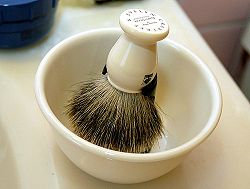 Apply the lather to your face
Apply the lather to your face
Some people prefer to face lather, others prefer to build the lather in a bowl, and still others still use canned shaving cream. Whatever you choose, apply the lather to your face. Make sure the lather is very slick. You can increase the lather by increasing the water. If you use a badger brush, you can dip the brush slightly in the hot water.
Click here to learn how we lather.
(Optional) Let the lather sit for a few minutes and reapply
Using a hot towel, wipe off the first lather and then reapply. Re-moisturize your brush and lather if necessary. We do not follow this step, but professional barbers and some straight razor users do. If your beard is coarse, we absolutely recommend following this step.
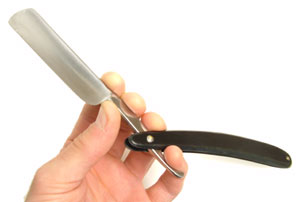 Get a firm grip upon your razor
Get a firm grip upon your razor
Most users use the three finger grip or four finger grip. Most straight razor grips position the scales in between the middle and ring fingers. Some users prefer to straddle the scales between the pinky and ring fingers. This is personal preference.
Use a 20°-35° degree angle of the blade to your skin. 35° is the greatest angle you should be using.
20° is a good starting point. Another tip is to lay the razor flat against your skin and raise the spine up two millimeters. Increase or the angle as required. Remember you are not trying to dig into your skin with the blade. You are using your skin as a cutting board of sorts and slicing the hairs, not your face.
Stretch your skin; watch this woman as she shaves a customer
http://youtu.be/KlBvY5QOX3Y
You will make three passes for optimal smoothness
- The first pass is with the grain. The goal is beard reduction, not removal. You will have a slight shadow if you do this pass correctly. While it is advisable to stop at this point for your first few shaves, proceed to the next step if your feeling extra confident and have excellent control over the razor.
- The next pass is across the grain. Again, beard reduction, not complete removal. You will still be able to feel the hairs at this stage. It is very highly recommended to stop at this point for your first few shaves.
- The final pass is against the grain. This is the hardest pass. It requires a good amount of skill and a moderate amount of dexterity to perform correctly. You are aiming to remove anything that is left during this pass.
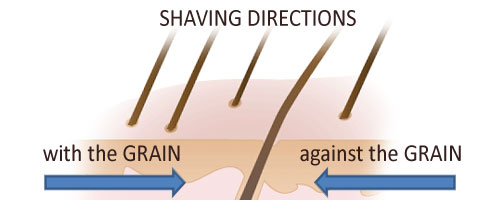 Make the first pass with the grain (in the direction of hair growth).
Make the first pass with the grain (in the direction of hair growth).
With the grain gives the least resistance when you run your hands in the same direction across your beard. It is important to determine the direction of beard growth. The following method is how I personally shave. You can switch up the order in any way you wish. There is no reason you have to shave the cheeks before your neck. However, following this method makes life a little more organized.
Shave the Right Cheek
Since most people are right handed, we will start with the right side of the face. Grasping the razor as shown above, make a downward stroke (blade first) holding the blade at a 30° angle to the skin. The angle is subjective and will change based upon your hair growth and razor sharpness. Use the lowest comfortable angle for best results.
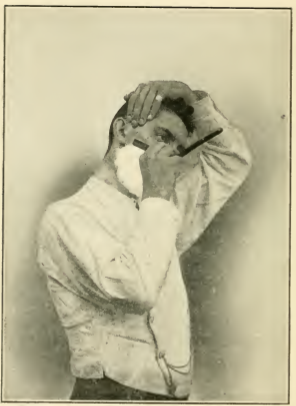 As you can see from the picture, skin stretching is essential (unless your face is perfectly taut). To stretch the skin, follow the picture. You are pulling upward and drawing the razor downwards. In other words, pull in the opposite direction of razor movement. As you shave downwards, move the left hand downwards as the lather is shaved away. Continue until you reach the jawline.
As you can see from the picture, skin stretching is essential (unless your face is perfectly taut). To stretch the skin, follow the picture. You are pulling upward and drawing the razor downwards. In other words, pull in the opposite direction of razor movement. As you shave downwards, move the left hand downwards as the lather is shaved away. Continue until you reach the jawline.
Shave the Left Cheek
There are two ways to do this side of your face. One method is to switch hands. If you choose this method, and any truly serious straight razor user does, just mirror the right side. Hold the razor with your left hand, pull with your right. I’ve mirrored the right side shaving image to help.
For those not so dexterous, follow the right side picture. As you can see, you have to change your plan of attack a little. Instead of shaving near the earlobe with the toe (tip) of the razor, you have to use the heel. Consequently, you won’t be able to get as close on this pass. The good news is that pulling with your left hand doesn’t involve reaching over your head. Anyway, just do the same thing on the left side as you did on the right.
Shave Under the Jaw
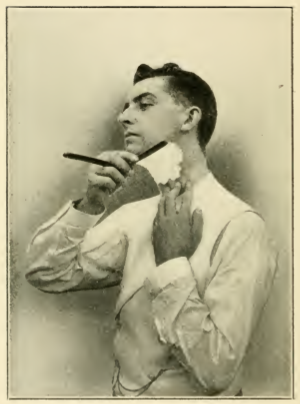
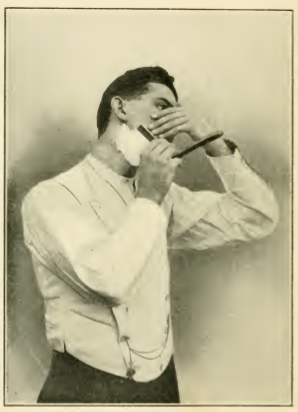
Shave the Chin
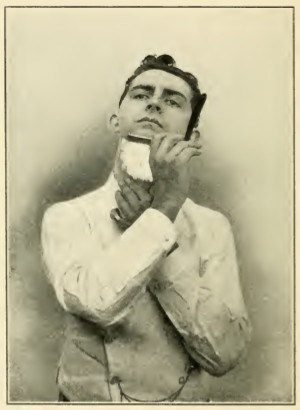 This is most certainly the hardest part. To do it, tilt your head upwards as before and pull down on your throat skin. It helps to shave the neck underneath the chin first. Then, placing the razor just under your bottom lip, shave downwards. Go slowly and take extra care. Not only is this skin extra sensitive, but your chin curves. Don’t go for extra close your first few times straight shaving. Just finish with a DE or disposable. Pride is not worth nicks and cuts.
This is most certainly the hardest part. To do it, tilt your head upwards as before and pull down on your throat skin. It helps to shave the neck underneath the chin first. Then, placing the razor just under your bottom lip, shave downwards. Go slowly and take extra care. Not only is this skin extra sensitive, but your chin curves. Don’t go for extra close your first few times straight shaving. Just finish with a DE or disposable. Pride is not worth nicks and cuts.
The Upper Lip/Moustache
This area is almost if not just as hard to shave as the chin. Except that the upper lip is flat. The nose has a tendency to get in the way. To get around the nose, angle the blade so that the spine is touching your nose, then make a “scooping” motion to shave downwards. The XTG pass is much easier. The ATG pass is not difficult, but if done improperly can cause irritation. Leaving the mustache alone after the XTG pass is not a bad idea.
Lather up again, and make the second pass across the grain (sideways).
Repeat the above steps. Except this time, shave sideways. For example, when shaving the right side, hold the razor so that the blade is vertical, place it in the middle of your face, and shave towards your ear. Then shave the other side going the opposite direction. Repeat. I should note that an across the grain pass on the neck and chin is extremely difficult. We recommend skipping it until you develop more skill with a straight razor.
Make a third and final pass against the grain.
Beginners may wish to simply skip this step. Just perform the against the grain pass backwards. For example, on the right side of the face, shave upwards. You need to change your grip on the razor to accommodate the new direction. You also need to lower the angle of the razor until the spine is just barely hovering over the skin.
Rinse the lather off your face with cold water
Cold water will help close the pores in your skin.
Dry the razor
This is extremely important. If you fail to dry off all the water from the razor, your razor will rust and will dull prematurely. If you got water in between your scales, run a square of toilet paper between the scales
Dry the brush
More on this topic later, but suffice to say, dry the brush out as thoroughly as you can.


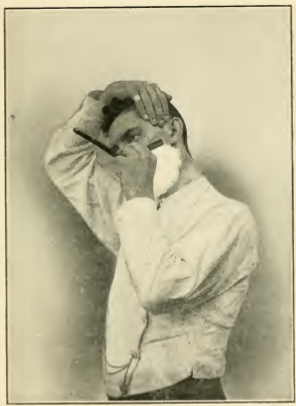
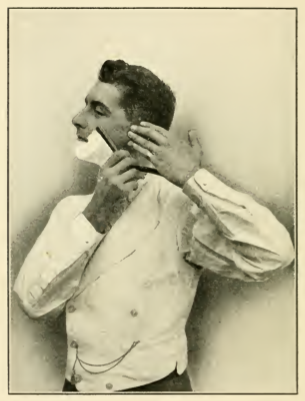
Great article. Fantastic advise. Can’t wait for my next shave! Thanks.
Not many comments?? I do not have a new straight edge. I have bought several antique straight edges and have sharpened mine on water stones or Arkansas stones, bought one strop, and powder for the back side and pastes I use on several heavy pieces of leather 5″ wide. I follow the instructions for sharpening my own, but I never seem to get the blade sharp enough. It is my understanding it is possible to get the blade too sharp. Can anyone confirm this. I do shave with these old razors but can never seem to get any closer than when I used the commercial razors, even the 5 blade razor.
Suggestions are very welcome as the cost of razor blades today is totally outrageous. Four for $30 or slightly less, ergo the reason I have gone back to my straight razor.
That photo at the top of the article must be a fake. I never use a 90 degree angle for any part of my shave. However, when you’re Robert Duvall, you use any angle you damn well please!
Lol, yes it was a staged photo. If I recall correctly, it’s from a NYT photo shoot.
Who the hell is robert duvall?
Help me please, the hair on my neck grows sideways. How do i shave my neck sideways? My fist attempt i shaved down so sideways.
Thanks for the help,
Kevin
There’s no easy way to shave sideways using a straight razor. The best option is to use the razor to shave diagonally, either downwards or upwards. To do so, use the heel instead of the toe to lead the blade. You’ll get it with practice. Alternatively, you can skip the WTG pass and just do one or two XTG pass(es).